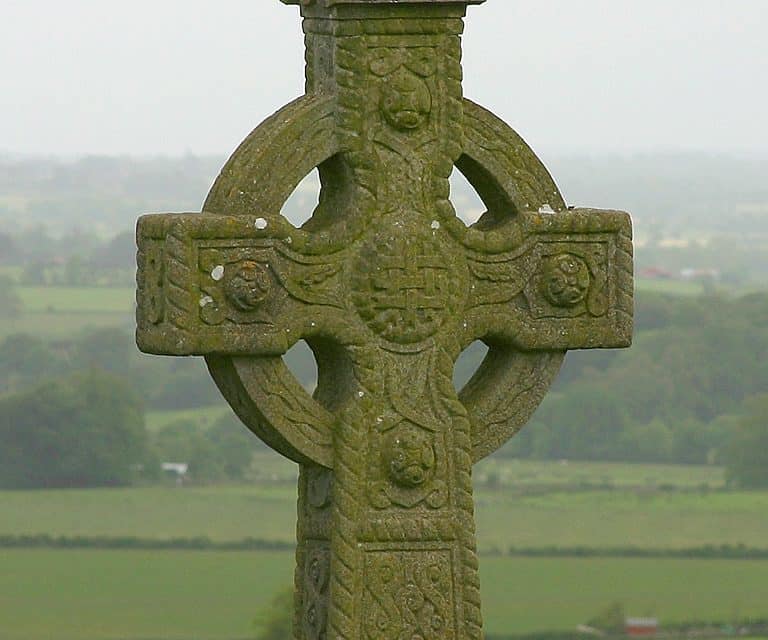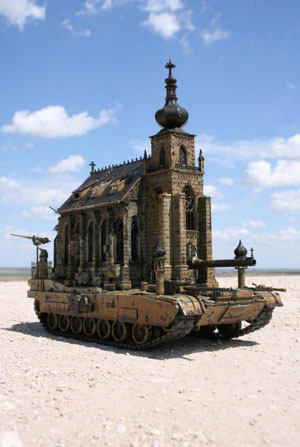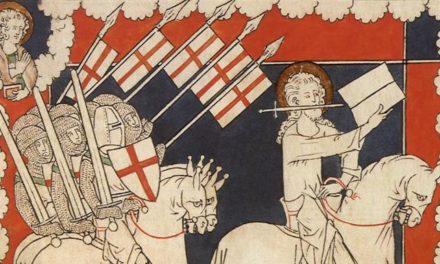This episode is titled – “Did Those Feet?” Why it bears that title is this . . .
Have you ever heard the anthem “Jerusalem”, whose lyrics come from a poem by William Blake? The song was performed by the 1970’s progressive rock band, Emerson, Lake & Palmer on their album, Brain Salad Surgery.
The opening lines are . . .
And did those feet in ancient time — Walk upon England’s mountains green?
And was the holy Lamb of God — On England’s pleasant pastures seen?
A mysterious riddle for those not aware of the ancient legends surrounding Britain’s entrance upon the Christian faith.
For centuries England prided itself that the church there was founded by Jesus himself. This tale was invoked in British disputes with France over preeminence & in late Protestant claims that Rome had nothing to do with the English church. It’s unclear how much the mystic, artist, and poet William Blake believed the tale, but his question remains famous.
In the Council of Basel in 1434, the Council decreed, “The churches of France and Spain must yield in points of antiquity and precedence to that of Britain, as the latter church was founded by Joseph of Arimathea immediately after the passion of Christ.”
Uh, huh?!!?
Okay, so à We all know this is supposed to be a history podcast, not a wild, flight of fancy, let’s repeated every crazy thing people have believed, podcast. So, why am I sharing this? It’s illustrative of how many, maybe even most, of the churches of the ancient world laid claim to a special origin and identity. By way of illustration, let’s look at the legends surrounding England’s embrace of the Faith.
According to well-established legend, Joseph of Arimathea, the Jewish leader who petitioned Pilate to bury Jesus’ body, was also Mary’s uncle. When Mary, Joseph and 12-year-old Jesus went to Jerusalem for Passover, it was at Uncle Joseph’s place they stayed. Sometime later, Uncle Joe took the teenage Jesus on a tin-trading trip to Glastonbury, in England.
Other legends put the adult Jesus in Glastonbury, using his constructions skills in making a house and working as a ship’s carpenter. Older and even less reliable legends leave Jesus in Israel but send Uncle Joseph to Britain alone 30 years after Jesus’ ascension.
In the 12th Century, a monk named William of Malmesbury made a record of the history of the Church at Glastonbury. In the introduction added a century later, the story goes that the Apostle Philip sent Joseph & 11 others to Britain where they were allowed to build a church there. Then, after yet another century, John of Glastonbury said Joseph of Arimathea was an ancestor of King Arthur & bringer of the Holy Grail to England.
Okay, enough of the legends. What is certain is Origen’s reference to the Gospel having been received among the Britons in the early 3rd Century. And the faith hadn’t just come there, it was widely accepted. Even the North African apologist Tertullian wrote in An Answer to the Jews some time around ad 200 that the Faith had taken root and was growing in Britain. The first church historian Eusebius notes that “some apostles passed over the ocean to what are called the British Isles.”
In AD 43, 2 years after Claudius was hailed Emperor of Rome, 40,000 Roman soldiers finally achieved Julius Caesar’s plan to invade Britain. Times had changed; Claudius invaded the island mainly because he could, and he needed the prestige of a military victory. Having landed on the coast of Kent, the legions subdued Wales and England, but found themselves overextended after a few victories against the Picts of Scotland.
The British Celts adapted quickly to the lifestyle of their Roman conquerors. Celtic languages were abandoned in favor of Latin, and Celts began bowing to the gods of the Roman pantheon.
It was because of this new Romanized British religion we learn the name of a British Christian: Alban.
Alban was a pagan, but a friendly one. He welcomed a Christian priest fleeing persecution into his home. Which persecution is uncertain but the Anglo-Saxon church historian the Venerable Bede says it was under Diocletian at the end of the 3rd Century. It didn’t take long for the priest’s devotion to influence Alban. He renounced idolatry and put his faith in Christ. But no sooner had Alban knelt in prayer than soldiers appeared at the door, having been informed of the priest’s location. The new convert swapped clothes with the priest. It wasn’t until Alban was brought before the judge that his identity was revealed. The judge said Alban would bear the priest’s punishment. He had only one out à to sacrifice to the idols. Alban refused.
The judge asked, “What’s your family and race?’
Alban replied, “What does that concern you? If you want to know the truth about my religion, know that I’m a Christian and practice Christian rites.’
The Judge blustered à “I demand to know your name!”
Alban answered, “My parents named me Alban. And I worship and adore the living and true God, who created all things.”
Again the judge ordered him to sacrifice to the pagan gods, & again he refused, saying whoever did so was “doomed to the pains of hell.” When beatings and whippings couldn’t change his mind, he was sentenced to death.
The story of Alban’s martyrdom goes on. While it’s difficult to sort out fact from legend, his tale gives us an idea of the high regard the martyrs were given in the Early Church. Supposedly on the way to the hill where Alban was to be executed, his guards were unable to cross a bridge because of the crowd that had gathered. So Alban parted the river as Moses had parted the sea. This was too much for his executioner, who instantly became a believer himself and joined Alban at the block where his head was removed from his shoulders.
Alban became Britain’s first, but by no means only, martyr. Turns out Alban & his former executioner weren’t the only ones martyred that day. So were 2 others.
One of the challenges historians face when reviewing the history of Christianity in England is the syncretism that often seems to mark its early years. Syncretism refers to the blending of different things. Religious syncretism is something the Church has had to deal with since its earliest days. In many places around the Roman Empire, while Christianity supplanted paganism, in a few places, pagan ideas and rituals were taken up and adopted by the Church. Old feast days were gutted of their pagan origin & made to represent Christian commemorations, and so on. It’s in England such syncretism stands out. Several artefacts reveal that conversion out of paganism into a clear NT Christianity was a slow process. Pagans and Christians worshipped side by side in the same building in Kent. Several British churches were built in imitation of pagan temples and shrines. A mosaic in Dorset includes both pagan and Christian themes. The same situation appears in Ireland, where pagan and Christian statues are found side by side.
While the assumption of most historians is that all this points to a syncretistic blurring of the lines between pagans & Christians, an alternative position sees the close proximity of pagan & Christian elements as evidence of a remarkable tolerance between the two groups. It may have been that the two groups shared the same location without conflating their faiths.
In 314, 3 bishops from Britain: Eborius from York, Restitutus of London & Adelphius from Lincoln, attended a church council at Arles, in southern Gaul. The Council was called to decide the issue of the Donatists in North Africa, which we’ve dealt with in an earlier episode. It was at this council Donatists were officially labeled heretics. British bishops were also present at Sardica in 343 & Armininum 16 years later.
That these British church leaders were able to attend these councils suggests they were organized early, well before Constantine’s Edict of Milan. It also means they had contact with the Church on the Continent. Monasticism, which would find such a prominent place in England, was a product of the Church in North Africa.
Monasticism came to England via the work of Martin of Tours. Martin was a military veteran from Hungary who, after his conversion to Christ, seems to have a hard time deciding whether he wanted to work in a church or a monastery. His real passion was evangelism. So he preached Christ to the unconverted & the asceticism of monastery-life to the already converted. One of those was a Briton named Ninian.
Ninian’s story, like so many from church history, is a shadowy tale clouded in legend. We’re not even sure that’s his real name. He was a missionary to the Picts in Scotland. Probably not the first to take the Gospel north of Hadrian’s Wall, he was the first to get credit for it. Martin urged several masons to go with Ninian to build a monastery at Whithorn. Venerable Bede says it was named The White House. It became a center of monastic activity, drawing students from Ireland & Wales.
Needing the legions to defend the empire from hostile Germanic tribes, in 407, Emperor Honorius recalled them to the Continent. Within just a few years, Roman rule of England was completely dismantled. In less than a generation nearly all traces of Roman culture, from philosophy to architecture was in ruins. And while many of the native Britons rejoiced as the Eagle flew south, they certainly did NOT appreciate the consequences as wave after wave of invaders washed over the land. The Picts came south from their highland homes. Scots invaded from Ireland. You might say, “Wait – Scots are from Scotland, not Ireland.” And that’s where a little known fact of history proves important. It wasn’t called Scotland at that time. Scot was the word used for the Irish. When they invaded and settled among the natives of northern Briton, it became known as the Land of the Scots.
The real change for Britain came when the Saxons invaded from Germany. Then the Saxons were flowed up by the Angles & Jutes from Denmark. Foreign cultures overran Britain, snuffing out the last vestiges of Roman culture. In the eastern region of the isle even Celtic culture nearly disappeared.
But it wasn’t just weapons that Saxonized & Anglicized the Britons. The British nobles who’d adopted Roman ways promptly “went-Saxon” so they could hang on to their social status. Immigration changed England’s demographics. Yet despite the large numbers of Northern Europeans who made their way to Britain’s shores, lots of ethnic Britons still inhabited 5th C England. Now without Roman infrastructure, life changed. Communication with the continent diminished. And with less interaction with Rome, the British church became insular. Older historians emphasized this isolation, using it to explain the independent mindset that marked the Medieval English Church. But it turns out while communication did in fact fall off, it didn’t cease altogether.
So while monasticism boomed in England after the Romans departed, and it took on a distinctly English form, it wasn’t utterly divorced from the monasticism practiced in the rest of Europe. And it wasn’t long before Celtic monks went forth from their isolation to carry Celtic Christianity to the mainland.





